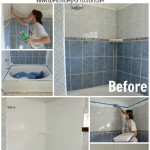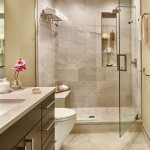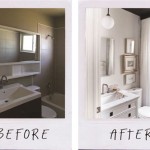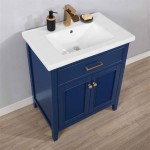Can You Use Luxury Vinyl Flooring In Bathrooms? A Comprehensive Guide
Luxury vinyl flooring (LVF) has gained significant popularity in recent years as a flooring option for various rooms within a house. This is due to its durability, aesthetic appeal, and relatively low cost compared to traditional materials such as hardwood or ceramic tile. However, the question of its suitability for bathrooms, particularly regarding water resistance and long-term performance, remains a frequent consideration for homeowners and contractors alike. This article provides a detailed examination of the use of luxury vinyl flooring in bathrooms, addressing its advantages, disadvantages, and essential installation factors to ensure optimal results.
Luxury vinyl flooring is a synthetic flooring material designed to mimic the appearance of natural materials like wood, stone, or tile. It is available in two main forms: luxury vinyl planks (LVP) and luxury vinyl tiles (LVT). LVP replicates the look of hardwood planks, while LVT mimics the appearance of ceramic or stone tiles. Both types generally consist of multiple layers, including a wear layer, a decorative layer, and a backing layer, contributing to their overall durability and resilience.
The primary concern when selecting flooring for a bathroom is its ability to withstand moisture and humidity. Bathrooms are inherently wet environments, subject to frequent spills, splashes, and elevated humidity levels, all of which can damage flooring materials that are not appropriately designed for such conditions. Understanding the properties of luxury vinyl flooring related to water resistance is crucial in determining its suitability for bathroom applications.
Water Resistance and Waterproofing Capabilities of Luxury Vinyl
A key advantage of luxury vinyl flooring is its inherent water resistance. Unlike natural wood or laminate flooring, luxury vinyl is manufactured from synthetic materials that do not readily absorb water. This characteristic makes it a more suitable option for bathrooms where water exposure is a constant factor. However, it is essential to differentiate between water resistance and waterproofing. While most luxury vinyl flooring offers excellent water resistance, not all products are completely waterproof.
Water-resistant flooring can withstand spills and splashes without immediate damage, provided the water is promptly cleaned up. A waterproof flooring, on the other hand, is impervious to water and can withstand prolonged exposure without warping, swelling, or other forms of water damage. Some luxury vinyl products are specifically engineered to be 100% waterproof, often featuring a core layer made of solid polymer or a similar impermeable material. These waterproof versions are particularly well-suited for bathrooms, as they provide a greater degree of protection against water-related issues.
The joints between planks or tiles in a luxury vinyl floor are potential points of water penetration. Even with water-resistant or waterproof materials, water can seep through these seams and potentially damage the subfloor. Therefore, proper installation, including the use of waterproof adhesives and sealants, is crucial to minimize the risk of water damage.
When selecting luxury vinyl flooring for a bathroom, it is crucial to carefully review the manufacturer's specifications regarding water resistance and waterproofing. Look for products that are explicitly labeled as waterproof for maximum protection. Additionally, consider the installation requirements and ensure that the installation process includes appropriate measures to seal seams and prevent water intrusion.
Advantages of Using Luxury Vinyl Flooring in Bathrooms
Beyond its water resistance, luxury vinyl flooring offers several other advantages that make it a favorable choice for bathrooms. These benefits contribute to its overall practicality and desirability as a flooring option for this demanding environment.
Firstly, luxury vinyl is known for its durability and resistance to wear and tear. The wear layer, a transparent protective coating on the surface of the flooring, shields the decorative layer from scratches, scuffs, and stains. This makes luxury vinyl flooring a suitable choice for high-traffic areas like bathrooms, where daily use can take a toll on flooring materials. A thicker wear layer provides greater protection and extends the lifespan of the flooring.
Secondly, luxury vinyl is relatively easy to maintain. Regular cleaning typically involves sweeping or vacuuming to remove dirt and debris, followed by occasional damp mopping with a mild cleaning solution. Unlike natural stone or tile, luxury vinyl does not require special sealants or polishing to maintain its appearance. Its stain resistance also simplifies the task of cleaning up spills and preventing permanent discoloration.
Thirdly, luxury vinyl provides a comfortable underfoot feel. Compared to hard surfaces like ceramic tile or stone, luxury vinyl has a softer and warmer texture, making it more comfortable to walk on, especially during colder months. Some luxury vinyl products also incorporate a cushioning layer that further enhances comfort and reduces noise transmission.
Fourthly, luxury vinyl offers a wide range of aesthetic options. With advancements in printing technology, luxury vinyl can accurately replicate the look and texture of natural materials, providing homeowners with a diverse selection of styles, colors, and patterns to choose from. Whether it is the look of hardwood, stone, or tile, luxury vinyl can effectively mimic the appearance of these materials at a fraction of the cost.
Fifthly, luxury vinyl is generally less expensive than many other flooring options, such as hardwood, stone, or ceramic tile. The lower material cost, combined with relatively easy installation, can make luxury vinyl a budget-friendly choice for bathroom renovations or new construction projects.
Installation Considerations for Bathrooms
Even with the inherent advantages of luxury vinyl flooring, proper installation is critical to ensure its long-term performance and prevent water damage. The installation process involves several key steps that must be carefully executed to achieve a successful outcome.
Prior to installation, the subfloor must be thoroughly prepared. This includes ensuring that the subfloor is clean, level, and dry. Any existing flooring materials, such as old tiles or carpeting, should be removed, and any imperfections in the subfloor should be repaired. Uneven surfaces can cause the luxury vinyl flooring to flex or buckle over time, potentially leading to damage or premature wear.
Depending on the type of luxury vinyl flooring, the installation method may vary. Some products utilize a click-lock system, where the planks or tiles interlock together without the need for adhesive. Other products require the use of adhesive to secure them to the subfloor. For bathrooms, it is generally recommended to use a waterproof adhesive to ensure a watertight seal between the flooring and the subfloor.
When installing luxury vinyl flooring around toilets, sinks, and other fixtures, it is essential to leave a small expansion gap to allow for thermal expansion and contraction. This gap is typically covered with a sealant or molding to prevent water from seeping underneath the flooring. Proper sealing around these fixtures is crucial to prevent water damage and maintain the integrity of the flooring.
The use of a vapor barrier is also recommended, especially in bathrooms with high humidity levels. A vapor barrier helps to prevent moisture from rising from the subfloor and damaging the luxury vinyl flooring. This is particularly important in bathrooms located on ground floors or in basements, where moisture levels tend to be higher.
Professional installation is often recommended, especially for complex bathroom layouts or when dealing with challenging subfloor conditions. Professional installers have the experience and expertise to properly prepare the subfloor, install the flooring correctly, and ensure that all seams and edges are properly sealed. This can help to minimize the risk of water damage and ensure that the flooring performs optimally over time.
In summary, the suitability of luxury vinyl flooring for bathrooms is contingent upon several factors, including the type of luxury vinyl selected, the quality of installation, and the specific conditions within the bathroom. By carefully considering these factors and taking appropriate measures to ensure proper installation and maintenance, homeowners can successfully utilize luxury vinyl flooring to create a durable, attractive, and water-resistant bathroom floor.

Luxury Vinyl Flooring Is A Great Choice For Chic Bathrooms

Vinyl Planks In Bathrooms Residential Inspiration Flooring

Dos And Don Ts For Installing Vinyl Plank Floors In The Bathroom Advice Homeowners

Can Vinyl Flooring Be Used In A Bathroom Hallmark Floors

12 Things You Should Know About Luxury Vinyl Tile Floor Coverings International

Best Vinyl Flooring For Bathrooms

Luxury Vinyl Tile Floors For A Bathroom The Ultimate Guide

Best Flooring In Portland For Bathrooms

How To Install Vinyl Plank Flooring In A Bathroom Fixthisbuildthat

Achieve High End Hardwood Looks For Your Dream Bath In Lvt
Related Posts







